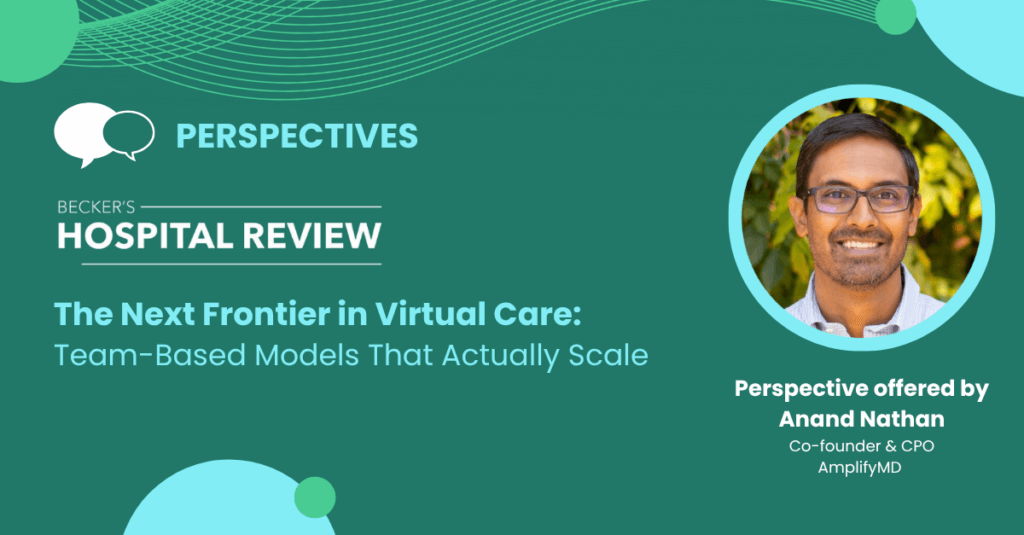AmplifyMD’s CEO, Meena Mallipeddi, regularly speaks with innovative healthcare leaders on her podcast, The Seamless Connection. This Q&A comes from her conversation with Brendan McNamara, CEO of Telemedicine at Sound Physicians. (The podcast conversation has been edited and condensed.)

Brendan McNamara
Telemedicine CEO
Sound Physicians
Brendan, what made you pursue a career in healthcare?
I actually started my professional career in the Army, where I had the opportunity to be a paratrooper and work in special operations. Then I had this wonderful opportunity to go to business school. As I reflected on what fields I wanted to pursue, I thought of what brought me joy and purpose in my Army career, which was really the opportunity to serve something greater than yourself. I really found that encouraging about healthcare. As I’ve built new businesses, my joy has always been in the ability to deliver value but at the same time have the opportunity to impact people and work towards this wonderful outcome, which is better healthcare for all.
What brought you to Sound Physicians?
By the time I came to Sound, I’d started home health agencies, worked for a private equity company that focused on helping health systems manage their post-acute spend more effectively, as well as worked on the payer side of healthcare. All of this led me to Sound Physicians, which had launched into telemedicine. I liked the idea of expanding the care model within the hospital setting but outside the walls of the building. They were taking a value-based care model built on a hospitalist practice to leverage the same skills and capabilities into post-acute marketing to improve outcomes and reduce costs.
Sound Physicians has focused on improving access to physicians in the post-acute space. Could you explain how this population has been underserved in the past and highlight the changes you have implemented to address this issue?
Historically, the lack of physician engagement on the post-acute side has been staggering – in skilled nursing facilities (SNF) and at home. No physician goes to a patient’s home or engages in home health episodes. Historically, in the middle of the night, if a patient falls or they have a significant change in condition, the RN on shift would wake up a physician or medical director in the middle of the night and have a very unsatisfying conversation that likely will end up with the patient getting sent out to a hospital emergency room. But if there is a physician awake and in front of a computer, ready to help the RN treat and manage patients, we can keep that from happening a lot of the time.
So to have telemedicine as a tool to bridge that engagement gap is invaluable. The technology enables us to use those hospitalists in a way that wouldn’t have been cost-effective in any other model. So, for example, a night nurse, when they see a fall at 2 am, can have a physician on video working with them within just a few minutes. Or, on our home health side, actually have our physicians perform start-of-care visits right with the nurse, engaging with them on medication reconciliation, in the patient’s own environment, which makes them more comfortable.
I fundamentally believe that we improve quality in post-acute care when we provide access to engaged physicians. When you add engaged physicians in a cost-effective way, it’s really impactful.
What are some of the biggest clinical challenges post-acute providers face, and how does telemedicine help?
Industry-wide, more and more post-acute facilities are being forced up the acuity curve. Patients in a skilled nursing facility today probably would have been in the hospital 15 years ago, so these facilities are taking care of much sicker and frailer patients than they would have historically. They are challenged to provide a higher level of care while still being accountable for 30-day readmissions or other quality outcomes. The post-acute industry is absolutely being squeezed. Telemedicine allows the staff to consult with a physician and assess treatment, whereas previously, they would just get sent to the emergency room. 96% of our connections result in treatment in place.
Like anything in healthcare, telemedicine adoption requires some change management, but facilities have seen about a 25% improvement and we’ve had some incredible results with facilities that have reduced their readmission rates 70-80%, over a period of months.
What are you excited about in 2023?
Sound has launched an Accountable Care Organization (ACO) specifically for patients and residents who live in nursing homes. Traditionally this is a very high cost and unmanaged population because their Medicare is FFS, and nobody is paying attention to the overall cost. There is a tremendous opportunity to deliver higher quality care and create some value through an ACO that brings together physicians, facilities, and other providers to focus on managing the cost, quality, and patient satisfaction. This allows the SNF an opportunity to participate in the care they are already providing. Our ACO is playing a small but critical role in helping the industry move forward.
How does telemedicine need to continue to evolve, and why?
Telemedicine is a cost-effective way to add clinical capacity. And it is an incredible opportunity to take the precious resources of clinicians and deploy them in a model that allows them to make a tremendous impact in a cost-effective way. But to be successful, you have to make telemedicine as simple and easy as possible for your staff to use, and it has to be integrated directly into the clinical workflow. This simplifies training and adoption and really aids the proactive collaboration that keeps staff engaged.
Listen to Brendan’s entire conversation with Meena Mallipeddi on Episode #13 of The Seamless Connection podcast hosted by Slice of Healthcare.





